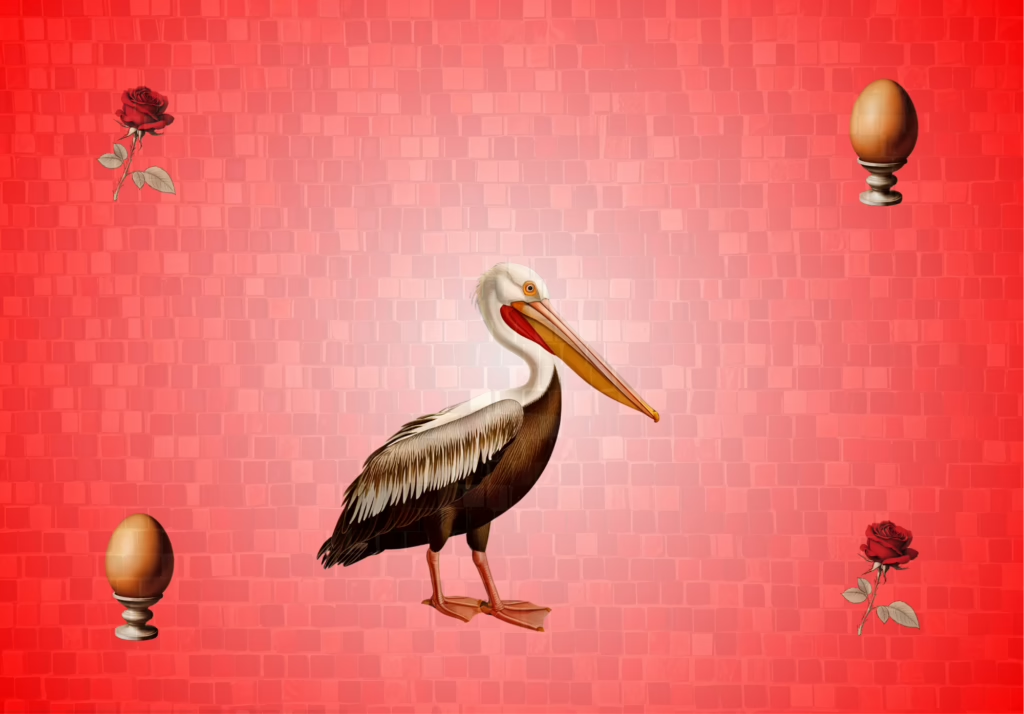Pelican, strange animal

The last stage of the alchemical work is rubedo
It is the fulfilment, the maturation, the definitive transformation
It is the point where nigredo and albedo embrace,
the black of shadow and the white of purification
merge into the red of blood, of life, of sacrifice
Rubedo is a mysterious territory,
a threshold where words begin to tremble,
definitions falter,
concepts dissolve
Little is spoken, little is contemplated
It has many symbols, the rubedo, let us take a strange one
the pelican
A bird that inhabits eastern Europe, south-western Asia, Africa,
and yet has inhabited even the most secret pages of the inner West for centuries
Bestiaries are not enough to understand it:
we rely on St Thomas Aquinas,
Doctor Angelicus,
tried to explain the Mystery with the logic of the soul
In his Eucharistic hymn he sings thus:
Pie pellicáne, Jesu Dómine,
Me immúndum munda tuo sánguine.
‘O pious pelican, Lord Jesus,
purify me, a sinner, with your blood.’
Thomas associates Christ with the pelican, and thus opens the door to an ancient legend, amplified by medieval literature
According to medieval bestiaries, in times of famine, the pelican kills its young in a fit of rage, but on the third day, repentant, it rips open its breast with its beak and with its own blood brings them back to life
It is the symbol of redemptive sacrifice, of death that generates life, of flesh that offers itself to transform the other
Dante knows this and it is no coincidence that, in Paradise, when speaking of John, he reverently writes
‘This is he who lay on the breast
of our pelican, and this was
from up the cross to the great elected office.’
(Paradise, XXV, 112-114)
Jesus is the pelican,
and John is the disciple who rests his head on the pierced heart,
already red with rubedo, already open to the gift
For centuries, the pelican has stood triumphant on illuminated manuscripts, pulpits and stained glass windows, ecclesiastical coats of arms, and astylar crosses, an esoteric and liturgical symbol of the faith that offers itself, of the flesh that is consumed for love.
The pelican is Christ himself, who embodies the ultimate version of rubedo
union of opposites,
material and spiritual,
earth and sky,
death and resurrection.
The rubedo is the gold hidden in the blood,
the light contained in the wound,
the point at which alchemy becomes Christology
The rubedo is Christ
It is the landing place of every alchemical process,
but also the new beginning.
Whoever reaches the rubedo,
does not go back,
and can no longer speak as before
He remains alone
But he is no longer alone
‘Similis factus sum pelican solitudinis:
factus sum sicut nycticorax in domicilio.’
(Psalm 102:7)
‘I am similar to the pelican of the desert,
like the owl of the ruins.’
Strange animal, the pelican, symbol of solitude and redemption, of care that is born from pain, of silence that knows how to give itself up to the last drop
Landing and new beginning of every alchemical process
One must be an initiate to find it a friend

Leave a Reply